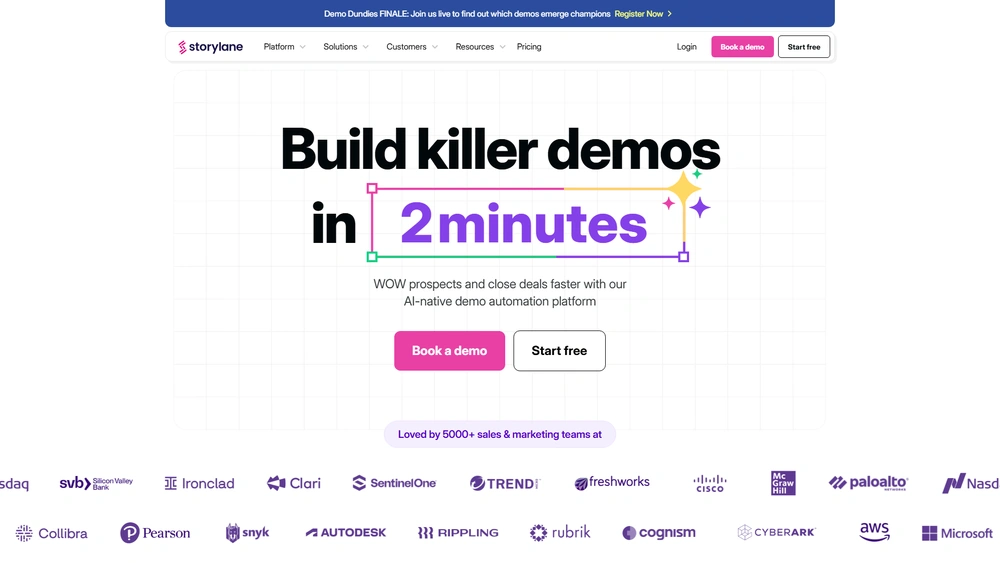Storylane Overview & 2025 Industry Position
Storylane is a no-code platform designed to help businesses create interactive, customer-facing product demos. With the rise of product-led growth and the decreasing effectiveness of static sales materials, Storylane’s ability to build personalized, interactive tours makes it a valuable asset for SaaS sales, marketing, and customer onboarding teams. In 2025, as B2B buying cycles prioritize fast, hands-on evaluations, Storylane’s approach aligns perfectly with emerging trends in PLG (Product-Led Growth), demo automation, and personalized sales enablement.
Storylane empowers go-to-market teams to showcase real product experiences without engineering costs—supporting high-conversion demo creation in just hours. Its drag-and-drop UX, robust analytics, and integrations with CRM and marketing platforms position it as a frontrunner in the interactive demo space.
From Launch to 2025: Storylane’s Journey
Founded in 2021, Storylane began as a tool for creating interactive walkthroughs of SaaS products. By 2022, it released key features like dynamic personalization and cross-domain embedding—quickly adopted by tech-forward marketing teams. In 2023, it raised Series A funding, fueling development of collaborative workflows and advanced analytics. During 2024, it added AI-powered step generation and deeper marketing automation links.
In 2025, Storylane aims to double down on demo-to-revenue conversion tools: empowering non-technical teams to launch, test, and scale demos that directly influence SQLs and pipeline velocity.

Storylane Key Features
Storylane offers a rich suite of features purpose-built for marketing and sales enablement teams. Its standout benefits include:
- No-Code Demo Builder: Create interactive product flows using a WYSIWYG interface—no technical teams required.
- Dynamic Personalization: Tailor demos for industries, personas, or accounts with token-based customization.
- Click & Scroll Tracking: Know exactly how users interact with your demo via advanced engagement analytics.
- Multi-Modal Embeds: Share via standalone links, landing pages, email embeds, or CRM integrations.
- Lead Gates & Attribution: Gate access to collect leads and parse conversion data back to your stack.
- AI-Powered Step Creation: Auto-generate explanations for demo sequences and edit via a visual builder.
Workflow & UX
Usability is where Storylane excels. The workflow begins with capturing your live application using their Chrome extension, then editing it directly within the platform’s step editor. Users can add tooltips, transitions, text inputs, and track user interactions—all without touching code.
Navigating the dashboard is intuitive. Users can duplicate projects, clone templates, and collaborate with other team members seamlessly. Their smart preview mode lets you test exactly what end-users will see—highlighting a thoughtful UX design prioritizing simplicity and speed.
Storylane Pricing Analysis & Value Metrics
As of July 2025, Storylane offers three core pricing tiers:
| Plan | Monthly | Key Features |
|---|---|---|
| Starter | $50/mo | 1 user, 2 demos, analytics, basic branding |
| Growth | $250/mo | 5 users, unlimited demos, lead gating, integrations |
| Scale | Custom | Unlimited users, white-labeling, CRM + BI sync, priority support |
For most SaaS startups and mid-market firms, the Growth plan hits the sweet spot in ROI—balancing usage flexibility with conversion analytics and marketing automation integration for scalable campaigns.
Competitive Landscape
| Tool | Strengths | Ideal For |
|---|---|---|
| Storylane | No-code, CRM-integrated demos, personalization | Startups to mid-market SaaS |
| Walnut | Sales-centric demo workflows | Mid-market sales teams |
| Reprise | Developer-heavy demo control | Enterprises with dev resources |
| Demoboost | Built-in voiceover + AI tours | Marketing-driven outreach |
Storylane shines in self-serve usability and startup-fit pricing—making it ideal for growing SaaS teams that need demo velocity without complexity. Reprise and Walnut cater more toward sales engineers or enterprise deployments requiring IT support.
Top Use Cases
Business types and workflows that benefit most from Storylane include:
- SaaS Product Marketing: Launch clickable product pages that engage prospects faster than static PDFs.
- Sales Enablement: Empower reps with personalized demo flows for each prospect segment.
- Customer Onboarding: Guide new users through live tool usage with embedded walkthroughs.
- RevOps & GTM: Use micro-demos tied to campaigns to attribute MQL-SQL movement.
Companies aiming to reduce demo latency while improving pipeline conversion rate typically see the greatest ROI.
Storylane Integrations
Integration is a strength for Storylane. The platform connects easily with:
- CRM Systems: HubSpot, Salesforce, Pipedrive
- Email Platforms: Marketo, Mailchimp, ActiveCampaign
- Analytics & CDP: Segment, GA4, Mixpanel
- Other SaaS: Notion, Webflow, Calendly embeds
This ecosystem allows marketing and sales teams to embed Storylane product tours into digital campaigns, then flow engagement data directly into their systems of record.
Pros & Cons
- Pros:
- Builds click-through, visual product tours in under an hour
- Great UX for non-technical users
- Expansive personalization & analytics
- HubSpot & Salesforce integrated lead flows
- Cons:
- Doesn’t support advanced backend simulation (yet)
- No mobile-native demo editor
- Requires initial walkthrough capture via Chrome
Final Thoughts
Storylane is a must-consider tool for SaaS marketers and AE teams ready to transform their product story into a conversion engine. It simplifies what used to take weeks of dev work into visually engaging experiences launchable in hours. Its best-fit markets are early- to mid-stage SaaS companies focused on PLG and self-educated buyers. For teams without technical bandwidth but needing interactive demos fast—Storylane is among the top solutions on offer in 2025.
Pro Tip: Pair Storylane demos with calendar embeds or chat widgets to create immediate conversion points within your walkthrough.
Storylane Q & A
Storylane is used to create interactive product demos without code, mainly for SaaS marketing, sales enablement, and customer onboarding.
No. Storylane is a no-code platform designed for marketers and sales teams to use without any developer input.
Yes. Storylane is especially effective for B2B sales, allowing reps to deliver personalized demo assets to prospects efficiently.
Storylane integrates with Salesforce, HubSpot, Marketo, GA4, Segment, and several marketing and CRM tools.
Yes. Storylane typically offers a free trial or freemium plan with limited demos and features—ideal for small teams to test it before upgrading.